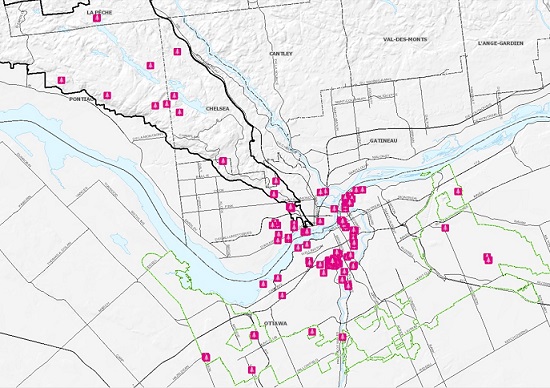Trees
Type of resources
Available actions
Topics
Keywords
Contact for the resource
Provided by
Formats
Representation types
Update frequencies
status
Resolution
-

FCOVER corresponds to the amount of the ground surface that is covered by vegetation, including the understory, when viewed vertically (from nadir). FCOVER is an indicator of the spatial extent of vegetation independent of land cover class. It is a dimensionless quantity that varies from 0 to 1, and as an intrinsic property of the canopy, is not dependent on satellite observation conditions.This product consists of FCOVER indicator during peak-season (June-July-August) at 100m resolution covering Canada's land mass.
-

Leaf area index (LAI) quantified the density of vegetation irrespective of land cover. LAI quantifies the total foliage surface area per groud surface area. LAI has been identified by the Global Climate Observing System as an essential climate variable required for ecosystem,weather and climate modelling and monitoring. This product consists of annual maps of the maximum LAI during a grownig season (June-July-August) at 100m resolution covering Canada's land mass.
-

Fraction of absorbed photosynthetically active radiation (fAPAR) quantified the absorbed by green foliage. fAPAR has been identified by the Global Climate Observing System as an essential climate variable required for ecosystem, weather and climate modelling and monitoring. This product consists of a national scale coverage (Canada) of monthly maps of fAPAR during a growing season (May-June-July-August-September) at 20m resolution. References: L. Brown, R. Fernandes, N. Djamai, C. Meier, N. Gobron, H. Morris, C. Canisius, G. Bai, C. Lerebourg, C. Lanconelli, M. Clerici, J. Dash. Validation of baseline and modified Sentinel-2 Level 2 Prototype Processor leaf area index retrievals over the United States IISPRS J. Photogramm. Remote Sens., 175 (2021), pp. 71-87, https://doi.org/10.1016/j.isprsjprs.2021.02.020. https://www.sciencedirect.com/science/article/pii/S0924271621000617 Richard Fernandes, Luke Brown, Francis Canisius, Jadu Dash, Liming He, Gang Hong, Lucy Huang, Nhu Quynh Le, Camryn MacDougall, Courtney Meier, Patrick Osei Darko, Hemit Shah, Lynsay Spafford, Lixin Sun, 2023. Validation of Simplified Level 2 Prototype Processor Sentinel-2 fraction of canopy cover, fraction of absorbed photosynthetically active radiation and leaf area index products over North American forests, Remote Sensing of Environment, Volume 293, https://doi.org/10.1016/j.rse.2023.113600. https://www.sciencedirect.com/science/article/pii/S0034425723001517
-

Vegetation biophysical parameters correspond to physical properties of vegetation structure (e.g. density, height, biomass), biochemistry (e.g. chlorophyll and water content) or energy exchange (e.g. albedo, temperature). These parameters have been identified by the Global Climate Observing System as an essential climate variable required for ecosystem, weather and climate modelling and monitoring. The Canada wide products are derived from systematically acquired satellite imagery with spatial resolution from 10m to 30m and provided as monthly temporal or peak-season composites due to cloud cover. Products are derived applying algorithms developed at Canada Centre for Remote Sensing (NRCan) to Copernicus Sentinel 2 satellite imagery. Select a related product first to view content.
-

Leaf area index (LAI) quantified the density of vegetation irrespective of land cover. LAI quantifies the total foliage surface area per ground surface area. LAI has been identified by the Global Climate Observing System as an essential climate variable required for ecosystem, weather and climate modelling and monitoring. This product consists of a national scale coverage (Canada) of monthly maps of the maximum LAI during a growing season (May-June-july-August-September) at 20m. References: L. Brown, R. Fernandes, N. Djamai, C. Meier, N. Gobron, H. Morris, C. Canisius, G. Bai, C. Lerebourg, C. Lanconelli, M. Clerici, J. Dash. Validation of baseline and modified Sentinel-2 Level 2 Prototype Processor leaf area index retrievals over the United States IISPRS J. Photogramm. Remote Sens., 175 (2021), pp. 71-87, https://doi.org/10.1016/j.isprsjprs.2021.02.020. https://www.sciencedirect.com/science/article/pii/S0924271621000617 Richard Fernandes, Luke Brown, Francis Canisius, Jadu Dash, Liming He, Gang Hong, Lucy Huang, Nhu Quynh Le, Camryn MacDougall, Courtney Meier, Patrick Osei Darko, Hemit Shah, Lynsay Spafford, Lixin Sun, 2023. Validation of Simplified Level 2 Prototype Processor Sentinel-2 fraction of canopy cover, fraction of absorbed photosynthetically active radiation and leaf area index products over North American forests, Remote Sensing of Environment, Volume 293, https://doi.org/10.1016/j.rse.2023.113600. https://www.sciencedirect.com/science/article/pii/S0034425723001517
-

FCOVER corresponds to the amount of the ground surface that is covered by vegetation, including the understory, when viewed vertically (from nadir). FCOVER is an indicator of the spatial extent of vegetation independent of land cover class. It is a dimensionless quantity that varies from 0 to 1, and as an intrinsic property of the canopy, is not dependent on satellite observation conditions. This product consists of a national scale coverage (Canada) of monthly maps of FCOVER indicator during a growing season (May-June-July-August-September) at 20m resolution. References: L. Brown, R. Fernandes, N. Djamai, C. Meier, N. Gobron, H. Morris, C. Canisius, G. Bai, C. Lerebourg, C. Lanconelli, M. Clerici, J. Dash. Validation of baseline and modified Sentinel-2 Level 2 Prototype Processor leaf area index retrievals over the United States IISPRS J. Photogramm. Remote Sens., 175 (2021), pp. 71-87, https://doi.org/10.1016/j.isprsjprs.2021.02.020. https://www.sciencedirect.com/science/article/pii/S0924271621000617 Richard Fernandes, Luke Brown, Francis Canisius, Jadu Dash, Liming He, Gang Hong, Lucy Huang, Nhu Quynh Le, Camryn MacDougall, Courtney Meier, Patrick Osei Darko, Hemit Shah, Lynsay Spafford, Lixin Sun, 2023. Validation of Simplified Level 2 Prototype Processor Sentinel-2 fraction of canopy cover, fraction of absorbed photosynthetically active radiation and leaf area index products over North American forests, Remote Sensing of Environment, Volume 293, https://doi.org/10.1016/j.rse.2023.113600. https://www.sciencedirect.com/science/article/pii/S0034425723001517
-
2 Billion Trees Program Forests and trees sustain life on Earth. Beyond the jobs that our sustainably managed forests provide, people living in Canada rely on forests for a wealth of benefits. Healthy forest ecosystems sustain thousands of living organisms, supply us with food, provide shelter and shade on a sunny day, clean the air we breathe and the water we drink, and hold spiritual significance for many, particularly within Indigenous cultures. The following 10 tree planting projects (out of 72 projects funded by the 2 Billion Trees program in 2021) are being showcased to highlight the diversity of projects funded across Canada. From the application of traditional ecological knowledge, habitat restoration, increasing tree biodiversity in urban centres, or engaging local residents in an effort to educate people on the importance of nature-based climate solutions, these projects demonstrate that planting trees brings a wealth of benefits for all Canadians, from coast to coast.
-

Mapping of the inventory of “potentially remarkable” trees on the territory of Quebec City.**This third party metadata element was translated using an automated translation tool (Amazon Translate).**
-

In celebration of the tremendous diversity of tree species that tell the story of our culture and history, the NCC released in September 2020 a compilation of close to 170 remarkable trees across Canada’s Capital region entitled A Living Legacy: Remarkable Trees of Canada’s Capital. An interactive map and downloadable book are available for free on the NCC’s website and will allow the public to discover distinctive features of these trees, revealing a story of the beauty of our natural heritage through the rich diversity of species thriving within Canada’s Capital. This compilation features trees according to their commonalities, which can include their physical relationship with the land, the fact that they were a source of food for Indigenous peoples, or for their contribution to the forest industry. https://ncc-ccn.gc.ca/remarkable-trees https://ncc-ccn.maps.arcgis.com/apps/MapJournal/index.html?appid=a9ba98fb7e8b4c2ba9be337235b95291
-

This data publication contains a set of 30m resolution raster files representing 2020 Canadian wall-to-wall maps of broad land cover type, forest canopy height, degree of crown closure and aboveground tree biomass, along with species composition of several major tree species. The Spatialized CAnadian National Forest Inventory data product (SCANFI) was developed using the newly updated National Forest Inventory photo-plot dataset, which consists of a regular sample grid of photo-interpreted high-resolution imagery covering all of Canada’s non-arctic landmass. SCANFI was produced using temporally harmonized summer and winter Landsat spectral imagery along with hundreds of tile-level regional models based on a novel k-nearest neighbours and random forest imputation method. A full description of all methods and validation analyses can be found in Guindon et al. (2024). As the Arctic ecozones are outside NFI’s covered areas, the vegetation attributes in these regions were predicted using a single random forest model. The vegetation attributes in these arctic areas could not be rigorously validated. The raster file « SCANFI_aux_arcticExtrapolationArea.tif » identifies these zones. SCANFI is not meant to replace nor ignore provincial inventories which could include better and more regularly updated inputs, training data and local knowledge. Instead, SCANFI was developed to provide a current, spatially-explicit estimate of forest attributes, using a consistent data source and methodology across all provincial boundaries and territories. SCANFI is the first coherent 30m Canadian wall-to-wall map of tree structure and species composition and opens novel opportunities for a plethora of studies in a number of areas, such as forest economics, fire science and ecology. # Limitations 1- The spectral disturbances of some areas disturbed by pests are not comprehensively represented in the training set, thus making it impossible to predict all defoliation cases. One such area, severely impacted by the recent eastern spruce budworm outbreak, is located on the North Shore of the St-Lawrence River. These forests are misrepresented in our training data, there is therefore an imprecision in our estimates. 2- Attributes of open stand classes, namely shrub, herbs, rock and bryoid, are more difficult to estimate through the photointerpretation of aerial images. Therefore, these estimates could be less reliable than the forest attribute estimates. 3- As reported in the manuscript, the uncertainty of tree species cover predictions is relatively high. This is particularly true for less abundant tree species, such as ponderosa pine and tamarack. The tree species layers are therefore suitable for regional and coarser scale studies. Also, the broadleaf proportion are slightly underestimated in this product version. 4- Our validation indicates that the areas in Yukon exhibit a notably lower R2 value. Consequently, estimates within these regions are less dependable. 5- Urban areas and roads are classified as rock, according to the 2020 Agriculture and Agri-Food Canada land-use classification map. Even though those areas contain mostly buildings and infrastructure, they may also contain trees. Forested urban parks are usually classified as forested areas. Vegetation attributes are also predicted for forested areas in agricultural regions. Updates of this dataset will eventually be available on this metadata page. # Details on the product development and validation can be found in the following publication: Guindon, L., Manka, F., Correia, D.L.P., Villemaire, P., Smiley, B., Bernier, P., Gauthier, S., Beaudoin, A., Boucher, J., and Boulanger, Y. 2024. A new approach for Spatializing the Canadian National Forest Inventory (SCANFI) using Landsat dense time series. Can. J. For. Res. https://doi.org/10.1139/cjfr-2023-0118 # Please cite this dataset as: Guindon L., Villemaire P., Correia D.L.P., Manka F., Lacarte S., Smiley B. 2023. SCANFI: Spatialized CAnadian National Forest Inventory data product. Natural Resources Canada, Canadian Forest Service, Laurentian Forestry Centre, Quebec, Canada. https://doi.org/10.23687/18e6a919-53fd-41ce-b4e2-44a9707c52dc # The following raster layers are available: • NFI land cover class values: Land cover classes include Water, Rock, Bryoid, Herbs, Shrub, Treed broadleaf, Treed mixed and Treed conifer • Aboveground tree biomass (tonnes/ha): biomass was derived from total merchantable volume estimates produced by provincial agencies • Height (meters): vegetation height • Crown closure (%): percentage of pixel covered by the tree canopy • Tree species cover (%): estimated as the proportion of the canopy covered by each tree species: o Balsam fir tree cover in percentage (Abies balsamea) o Black spruce tree cover in percentage (Picea mariana) o Douglas fir tree cover in percentage (Pseudotsuga menziesii) o Jack pine tree cover in percentage (Pinus banksiana) o Lodgepole pine tree cover in percentage (Pinus contorta) o Ponderosa pine tree cover in percentage (Pinus ponderosa) o Tamarack tree cover in percentage (Larix laricina) o White and red pine tree cover in percentage (Pinus strobus and Pinus resinosa) o Broadleaf tree cover in percentage (PrcB) o Other coniferous tree cover in percentage (PrcC)
 Arctic SDI catalogue
Arctic SDI catalogue